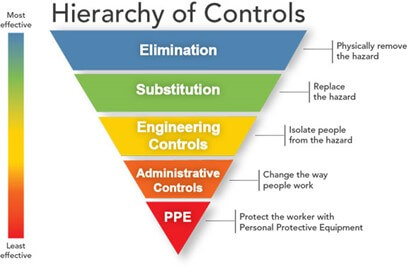Anticipating and controlling exposure to hazards is a fundamental component of safeguarding public and worker health. In both occupational and non-occupational settings, common hazards range widely, from trip hazards to airborne pollutants/pathogens. Public and commercial building/business owners can use a range of administrative and engineering controls to approach different types of hazards in different environments. While implementing controls is an excellent step toward illness and injury prevention, it is critical, once controls are in place, to evaluate whether they are successful in serving the intended purpose. In short, do they actually work? It has never been clearer than now, that an effective hazard mitigation strategy must include validation that the selected controls are effective, because in the absence of validation, controls are simply window dressing.
The traditional NIOSH hierarchy of controls, as seen in the illustration below, is a recognized approach that emphasizes reduction of injuries, illnesses and fatalities through a “Prevention Through Design” strategy.

The Hierarchy of Controls emphasizes first eliminating or replacing hazards where possible. When not possible, the Hierarchy recommends use of engineering and administrative controls to mitigate hazard. While elimination or substitution of a hazard are considered the most effective methods of control, remove the hazard before any chance of contact with the worker, this approach may often the most difficult to implement. In many cases, it is simply not possible to remove a hazard (such as with SARS-COV-2) or the measures needed to remove/replace the hazard require major, expensive and difficult changes to equipment and/or processes. Thus, engineering controls, isolating the hazard, are often used to protect the safety of workers and the public. Examples of engineering controls include local exhaust ventilation and machine guarding. Administrative controls, or changing how individuals occupy and interact in a given space (i.e. social distancing measures, lowered capacity limits and temperature scans), are next to be considered, followed by Personal Protective Equipment (PPE) as a last line of defense. Because administrative controls and PPE require behavioral changes, there is a higher likelihood of lapses and errors and are considered the least protective in the Heirarchy. As we’ve seen with the COVID-19 pandemic, it is very common for multiple control methods to be implemented simultaneously to address different levels of a single hazard.
Once the methods of engineering, administrative, and/or PPE control for a workplace or public space are chosen, it should be emphasized that the single act of implementing controls is simply “hygiene theater” if a validation step is not taken. Validation is the only way to determine whether controls are mitigating the hazards as anticipated, and to verify the effectiveness of a change. To ensure that implemented control measures are and continue to be effective, employers should:
- Track the application of controls by making sure the measures were implemented correctly, are properly installed, and are rigorously tested;
- Conduct personal hygiene monitoring as appropriate to confirm the controls are operating to their design purpose;
- Evaluate the controls to make sure they are effective.
If, after investigation, the control measures are found inadequate or the mitigate of the hazard is insufficient, employers should then:
- Determine why the equipment/strategy is not functioning as planned;
- Modify the existing control measures and identify and implement further control measures if needed;
- After modifications, confirm the new measures are effective by following the steps outlined above.
Not verifying the efficacy of hazard control measures can nullify the cost and effort of installing the control measures, and lead to costly liability and lost work time because the controls are not effective. Implementing hazard control measures and properly verifying their successful application provides employers and business owners not only the ability to protect workers and building occupants by providing an environment safe from recognized hazards, it further provides the security of having documentation of proven hazard controls. Industrial hygienists and occupational health and safety specialists can help employers: assess the potential risks to employees in their workplace; design mitigation strategies using the Hierarchy of Controls; and conduct the essential verification step in order to ensure the implemented controls are effective.
At RHP Risk Management, we help our clients navigate the uncertainties associated with environmental and occupational hazards and risks and can assist with assessing and addressing occupational hazards in the workplace. Our staff of public health professionals are experienced and trained in recognizing, anticipating and controlling hazards. For more information on RHP’s services and contact information, please visit www.rhprisk.com.
